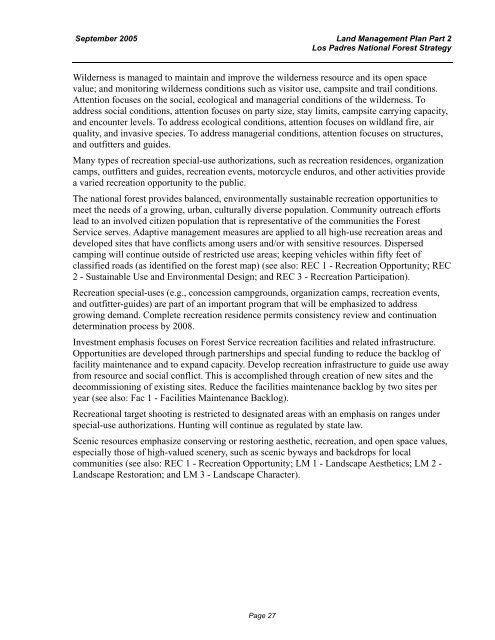Land Management Plan - Part 2 Los Padres National Forest Strategy
Land Management Plan - Part 2 Los Padres National Forest Strategy
Land Management Plan - Part 2 Los Padres National Forest Strategy
You also want an ePaper? Increase the reach of your titles
YUMPU automatically turns print PDFs into web optimized ePapers that Google loves.
September 2005 <strong>Land</strong> <strong>Management</strong> <strong>Plan</strong> <strong>Part</strong> 2<br />
<strong>Los</strong> <strong>Padres</strong> <strong>National</strong> <strong>Forest</strong> <strong>Strategy</strong><br />
Wilderness is managed to maintain and improve the wilderness resource and its open space<br />
value; and monitoring wilderness conditions such as visitor use, campsite and trail conditions.<br />
Attention focuses on the social, ecological and managerial conditions of the wilderness. To<br />
address social conditions, attention focuses on party size, stay limits, campsite carrying capacity,<br />
and encounter levels. To address ecological conditions, attention focuses on wildland fire, air<br />
quality, and invasive species. To address managerial conditions, attention focuses on structures,<br />
and outfitters and guides.<br />
Many types of recreation special-use authorizations, such as recreation residences, organization<br />
camps, outfitters and guides, recreation events, motorcycle enduros, and other activities provide<br />
a varied recreation opportunity to the public.<br />
The national forest provides balanced, environmentally sustainable recreation opportunities to<br />
meet the needs of a growing, urban, culturally diverse population. Community outreach efforts<br />
lead to an involved citizen population that is representative of the communities the <strong>Forest</strong><br />
Service serves. Adaptive management measures are applied to all high-use recreation areas and<br />
developed sites that have conflicts among users and/or with sensitive resources. Dispersed<br />
camping will continue outside of restricted use areas; keeping vehicles within fifty feet of<br />
classified roads (as identified on the forest map) (see also: REC 1 - Recreation Opportunity; REC<br />
2 - Sustainable Use and Environmental Design; and REC 3 - Recreation <strong>Part</strong>icipation).<br />
Recreation special-uses (e.g., concession campgrounds, organization camps, recreation events,<br />
and outfitter-guides) are part of an important program that will be emphasized to address<br />
growing demand. Complete recreation residence permits consistency review and continuation<br />
determination process by 2008.<br />
Investment emphasis focuses on <strong>Forest</strong> Service recreation facilities and related infrastructure.<br />
Opportunities are developed through partnerships and special funding to reduce the backlog of<br />
facility maintenance and to expand capacity. Develop recreation infrastructure to guide use away<br />
from resource and social conflict. This is accomplished through creation of new sites and the<br />
decommissioning of existing sites. Reduce the facilities maintenance backlog by two sites per<br />
year (see also: Fac 1 - Facilities Maintenance Backlog).<br />
Recreational target shooting is restricted to designated areas with an emphasis on ranges under<br />
special-use authorizations. Hunting will continue as regulated by state law.<br />
Scenic resources emphasize conserving or restoring aesthetic, recreation, and open space values,<br />
especially those of high-valued scenery, such as scenic byways and backdrops for local<br />
communities (see also: REC 1 - Recreation Opportunity; LM 1 - <strong>Land</strong>scape Aesthetics; LM 2 -<br />
<strong>Land</strong>scape Restoration; and LM 3 - <strong>Land</strong>scape Character).<br />
Page 27
















